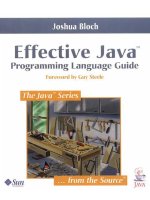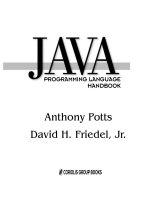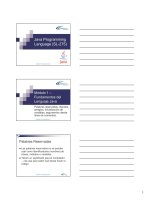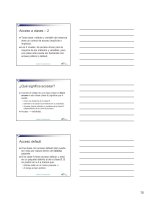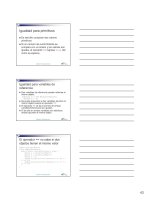Java programming language
Bạn đang xem bản rút gọn của tài liệu. Xem và tải ngay bản đầy đủ của tài liệu tại đây (1.11 MB, 456 trang )
Sun Services
Java™ Programming Language
SL-275
Java™ Programming Language
Copyright 2005 Sun Microsystems, Inc., 4150 Network Circle, Santa Clara, California 95054, U.S.A. All rights reserved.
This product or document is protected by copyright and distributed under licenses restricting its use, copying, distribution, and decompilation. No part of this product or document may
be reproduced in any form by any means without prior written authorization of Sun and its licensors, if any.
Third-party software, including font technology, is copyrighted and licensed from Sun suppliers.
Sun, Sun Microsystems, the Sun Logo, Java, JavaBeans, JavaOS, JDBC, JDK, JVM, J2SE, Jini, and Solaris are trademarks or registered trademarks of Sun Microsystems, Inc. in the U.S. and
other countries.
UNIX is a registered trademark in the U.S. and other countries, exclusively licensed through X/Open Company, Ltd.
Netscape Navigator is a trademark of Netscape Communications Corporation.
The OPEN LOOK and Sun Graphical User Interface was developed by Sun Microsystems, Inc. for its users and licensees. Sun acknowledges the pioneering efforts of Xerox in researching
and developing the concept of visual or graphical user interfaces for the computer industry. Sun holds a non-exclusive license from Xerox to the Xerox Graphical User Interface, which
license also covers Sun’s licensees who implement OPEN LOOK GUIs and otherwise comply with Sun’s written license agreements.
U.S. Government approval might be required when exporting the product.
RESTRICTED RIGHTS: Use, duplication, or disclosure by the U.S. Government is subject to restrictions of FAR 52.227-14(g)(2)(6/87) and FAR 52.227-19(6/87), or DFAR 252.227-7015
(b)(6/95) and DFAR 227.7202-3(a).
DOCUMENTATION IS PROVIDED “AS IS” AND ALL EXPRESS OR IMPLIED CONDITIONS, REPRESENTATIONS, AND WARRANTIES, INCLUDING ANY IMPLIED WARRANTY
OF MERCHANTABILITY, FITNESS FOR A PARTICULAR PURPOSE OR NON-INFRINGEMENT, ARE DISCLAIMED, EXCEPT TO THE EXTENT THAT SUCH DISCLAIMERS ARE
HELD TO BE LEGALLY INVALID.
Export Commodity Classification Number Assigned: 2 February 2002
Copyright 2005 Sun Microsystems Inc., 4150 Network Circle, Santa Clara, California 95054, Etats-Unis. Tous droits réservés.
Ce produit ou document est protégé par un copyright et distribué avec des licences qui en restreignent l’utilisation, la copie, la distribution, et la décompilation. Aucune partie de ce
produit ou document ne peut être reproduite sous aucune forme, par quelque moyen que ce soit, sans l’autorisation préalable et écrite de Sun et de ses bailleurs de licence, s’il y en a.
Le logiciel détenu par des tiers, et qui comprend la technologie relative aux polices de caractères, est protégé par un copyright et licencié par des fournisseurs de Sun.
Sun, Sun Microsystems, the Sun Logo, Java, JavaBeans, JavaOS, JDBC, JDK, JVM, J2SE, Jini, et Solaris sont des marques de fabrique ou des marques déposées de Sun Microsystems, Inc.
aux Etats-Unis et dans d’autres pays.
UNIX est une marques déposée aux Etats-Unis et dans d’autres pays et licenciée exclusivement par X/Open Company, Ltd.
Netscape Navigator est une marque de Netscape Communications Corporation aux Etats-Unis et dans d’autres pays.
L’interfaces d’utilisation graphique OPEN LOOK et Sun™ a été développée par Sun Microsystems, Inc. pour ses utilisateurs et licenciés. Sun reconnaît les efforts de pionniers de Xerox
pour larecherche et le développement du concept des interfaces d’utilisation visuelle ou graphique pour l’industrie de l’informatique. Sun détient une licence non exclusive de Xerox sur
l’interface d’utilisation graphique Xerox, cette licence couvrant également les licenciés de Sun qui mettent en place l’interface d’utilisation graphique OPEN LOOK et qui en outre se
conforment aux licences écrites de Sun.
L’accord du gouvernement américain est requis avant l’exportation du produit.
LA DOCUMENTATION EST FOURNIE “EN L’ETAT” ET TOUTES AUTRES CONDITIONS, DECLARATIONS ET GARANTIES EXPRESSES OU TACITES SONT FORMELLEMENT
EXCLUES, DANS LA MESURE AUTORISEE PAR LA LOI APPLICABLE, Y COMPRIS NOTAMMENT TOUTE GARANTIE IMPLICITE RELATIVE A LA QUALITE MARCHANDE, A
L’APTITUDE A UNE UTILISATION PARTICULIERE OU A L’ABSENCE DE CONTREFAÇON.
Course Contents
About This Course ..................................................................................... Preface-xvi
Course Goals .............................................................................................................................Preface-xvii
Course Overview ...................................................................................................................... Preface-xix
Course Map ................................................................................................................................. Preface-xx
Topics Not Covered .................................................................................................................. Preface-xxi
How Prepared Are You? .........................................................................................................Preface-xxii
Introductions ...........................................................................................................................Preface-xxiii
How to Use the Icons ..............................................................................................................Preface-xxiv
Typographical Conventions and Symbols ...........................................................................Preface-xxv
Getting Started ......................................................................................................... 1-1
Objectives ................................................................................................................................................. 1-2
Relevance .................................................................................................................................................. 1-3
What Is the Java™ Technology? ........................................................................................................... 1-4
Primary Goals of the Java Technology ................................................................................................ 1-5
The Java Virtual Machine ...................................................................................................................... 1-8
Garbage Collection ............................................................................................................................... 1-11
The Java Runtime Environment .......................................................................................................... 1-12
Operation of the JRE With a Just-In-Time (JIT) Compiler .............................................................. 1-13
JVM™ Tasks ........................................................................................................................................... 1-14
The Class Loader ................................................................................................................................... 1-15
The Bytecode Verifier ........................................................................................................................... 1-16
A Simple Java Application ................................................................................................................... 1-17
The TestGreeting Application ......................................................................................................... 1-18
The Greeting Class .............................................................................................................................. 1-19
Compiling and Running the TestGreeting Program .................................................................... 1-20
Java™ Programming Language
2005 Sun Microsystems, Inc. All Rights Reserved. Sun Services, Revision F
iv
Sun Services
Compile-Time Errors ............................................................................................................................ 1-21
Runtime Errors ...................................................................................................................................... 1-22
Java Technology Runtime Environment ........................................................................................... 1-23
Object-Oriented Programming ................................................................................ 2-1
Objectives ................................................................................................................................................. 2-2
Relevance .................................................................................................................................................. 2-3
Software Engineering ............................................................................................................................. 2-4
The Analysis and Design Phase ............................................................................................................ 2-5
Abstraction ............................................................................................................................................... 2-6
Classes as Blueprints for Objects .......................................................................................................... 2-7
Declaring Java Technology Classes ...................................................................................................... 2-8
Declaring Attributes ............................................................................................................................... 2-9
Declaring Methods ................................................................................................................................ 2-10
Accessing Object Members .................................................................................................................. 2-11
Information Hiding ............................................................................................................................... 2-12
Encapsulation ........................................................................................................................................ 2-14
Declaring Constructors ........................................................................................................................ 2-15
The Default Constructor ...................................................................................................................... 2-16
Source File Layout ................................................................................................................................ 2-17
Software Packages ................................................................................................................................ 2-18
The package Statement ........................................................................................................................ 2-19
The import Statement .......................................................................................................................... 2-20
Directory Layout and Packages .......................................................................................................... 2-21
Development ......................................................................................................................................... 2-22
Compiling Using the -d Option ......................................................................................................... 2-23
Terminology Recap ............................................................................................................................... 2-24
Using the Java Technology API Documentation .............................................................................. 2-25
Java Technology API Documentation With HTML3 ....................................................................... 2-26
Java™ Programming Language
Copyright 2005 Sun Microsystems, Inc. All Rights Reserved. Sun Services, Revision F
v
Sun Services
Identifiers, Keywords, and Types ........................................................................... 3-1
Objectives ................................................................................................................................................. 3-2
Relevance .................................................................................................................................................. 3-4
Comments ................................................................................................................................................ 3-5
Semicolons, Blocks, and White Space .................................................................................................. 3-6
Identifiers ................................................................................................................................................. 3-9
Java Programming Language Keywords .......................................................................................... 3-10
Primitive Types ..................................................................................................................................... 3-11
Logical – boolean ................................................................................................................................. 3-12
Textual – char ....................................................................................................................................... 3-13
Textual – String ................................................................................................................................... 3-14
Integral – byte, short, int, and long ............................................................................................... 3-15
Floating Point – float and double .................................................................................................... 3-17
Variables, Declarations, and Assignments ........................................................................................ 3-19
Java Reference Types ............................................................................................................................ 3-20
Constructing and Initializing Objects ................................................................................................ 3-21
Memory Allocation and Layout .......................................................................................................... 3-22
Explicit Attribute Initialization ........................................................................................................... 3-23
Executing the Constructor ................................................................................................................... 3-24
Assigning a Variable ............................................................................................................................. 3-25
Assigning References ............................................................................................................................ 3-26
Pass-by-Value ........................................................................................................................................ 3-27
The this Reference ............................................................................................................................... 3-32
Java Programming Language Coding Conventions ........................................................................ 3-36
Expressions and Flow Control ............................................................................... 4-1
Objectives ................................................................................................................................................. 4-2
Relevance .................................................................................................................................................. 4-4
Variables and Scope ................................................................................................................................ 4-5
Variable Scope Example ......................................................................................................................... 4-6
Java™ Programming Language
Copyright 2005 Sun Microsystems, Inc. All Rights Reserved. Sun Services, Revision F
vi
Sun Services
Variable Initialization ............................................................................................................................. 4-7
Initialization Before Use Principle ........................................................................................................ 4-8
Operator Precedence .............................................................................................................................. 4-9
Logical Operators .................................................................................................................................. 4-10
Bitwise Logical Operators .................................................................................................................... 4-11
Right-Shift Operators >> and >>> ....................................................................................................... 4-12
Left-Shift Operator << .......................................................................................................................... 4-13
Shift Operator Examples ...................................................................................................................... 4-14
String Concatenation With + ............................................................................................................... 4-15
Casting .................................................................................................................................................... 4-16
Promotion and Casting of Expressions .............................................................................................. 4-17
Simple if, else Statements .............................................................................................................. 4-18
Complex if, else Statements .......................................................................................................... 4-19
Switch Statements ................................................................................................................................. 4-21
Looping Statements .............................................................................................................................. 4-24
Special Loop Flow Control .................................................................................................................. 4-27
The break Statement ............................................................................................................................ 4-28
The continue Statement ..................................................................................................................... 4-29
Using break Statements with Labels ................................................................................................. 4-30
Using continue Statements with Labels .......................................................................................... 4-31
Arrays ........................................................................................................................ 5-1
Objectives ................................................................................................................................................. 5-2
Relevance .................................................................................................................................................. 5-3
Declaring Arrays ..................................................................................................................................... 5-4
Creating Arrays ....................................................................................................................................... 5-5
Creating Reference Arrays ..................................................................................................................... 5-7
Initializing Arrays ................................................................................................................................... 5-9
Multidimensional Arrays ..................................................................................................................... 5-10
Array Bounds ........................................................................................................................................ 5-12
Java™ Programming Language
Copyright 2005 Sun Microsystems, Inc. All Rights Reserved. Sun Services, Revision F
vii
Sun Services
Using the Enhanced for Loop ............................................................................................................ 5-13
Array Resizing ....................................................................................................................................... 5-14
Copying Arrays ..................................................................................................................................... 5-15
Class Design ............................................................................................................. 6-1
Objectives ................................................................................................................................................. 6-2
Relevance .................................................................................................................................................. 6-3
Subclassing ............................................................................................................................................... 6-4
Single Inheritance .................................................................................................................................... 6-7
Access Control ......................................................................................................................................... 6-9
Overriding Methods ............................................................................................................................. 6-10
Overridden Methods Cannot Be Less Accessible ............................................................................. 6-12
Invoking Overridden Methods ........................................................................................................... 6-13
Polymorphism ....................................................................................................................................... 6-15
Virtual Method Invocation .................................................................................................................. 6-17
Heterogeneous Collections .................................................................................................................. 6-18
Polymorphic Arguments ..................................................................................................................... 6-19
The instanceof Operator ................................................................................................................... 6-20
Casting Objects ...................................................................................................................................... 6-21
Overloading Methods .......................................................................................................................... 6-23
Methods Using Variable Arguments ................................................................................................. 6-24
Overloading Constructors ................................................................................................................... 6-25
Constructors Are Not Inherited .......................................................................................................... 6-27
Invoking Parent Class Constructors ................................................................................................... 6-28
Constructing and Initializing Objects: A Slight Reprise .................................................................. 6-30
Constructor and Initialization Examples ........................................................................................... 6-31
The Object Class .................................................................................................................................. 6-34
The equals Method .............................................................................................................................. 6-35
An equals Example ............................................................................................................................. 6-36
The toString Method ......................................................................................................................... 6-40
Java™ Programming Language
Copyright 2005 Sun Microsystems, Inc. All Rights Reserved. Sun Services, Revision F
viii
Sun Services
Wrapper Classes .................................................................................................................................... 6-41
Autoboxing of Primitive Types ........................................................................................................... 6-43
Advanced Class Features ....................................................................................... 7-1
Objectives ................................................................................................................................................. 7-2
Relevance .................................................................................................................................................. 7-3
The static Keyword ............................................................................................................................. 7-4
Class Attributes ....................................................................................................................................... 7-5
Class Methods ......................................................................................................................................... 7-7
Static Initializers .................................................................................................................................... 7-10
The final Keyword ............................................................................................................................. 7-12
Final Variables ....................................................................................................................................... 7-13
Blank Final Variables ............................................................................................................................ 7-14
Old-Style Enumerated Type Idiom .................................................................................................... 7-15
The New Enumerated Type ................................................................................................................ 7-19
Advanced Enumerated Types ............................................................................................................. 7-23
Static Imports ......................................................................................................................................... 7-25
Abstract Classes ..................................................................................................................................... 7-27
The Solution ........................................................................................................................................... 7-31
Interfaces ................................................................................................................................................ 7-34
The Flyer Example ................................................................................................................................ 7-35
Multiple Interface Example ................................................................................................................. 7-42
Uses of Interfaces .................................................................................................................................. 7-44
Exceptions and Assertions ..................................................................................... 8-1
Objectives ................................................................................................................................................. 8-2
Relevance .................................................................................................................................................. 8-3
Exceptions and Assertions ..................................................................................................................... 8-4
Exceptions ................................................................................................................................................ 8-5
Exception Example ................................................................................................................................. 8-6
Java™ Programming Language
Copyright 2005 Sun Microsystems, Inc. All Rights Reserved. Sun Services, Revision F
ix
Sun Services
The try-catch Statement ..................................................................................................................... 8-7
Call Stack Mechanism .......................................................................................................................... 8-10
The finally Clause ............................................................................................................................. 8-11
Exception Categories ............................................................................................................................ 8-12
Common Exceptions ............................................................................................................................. 8-13
The Handle or Declare Rule ................................................................................................................ 8-14
Method Overriding and Exceptions ................................................................................................... 8-15
Creating Your Own Exceptions .......................................................................................................... 8-17
Handling a User-Defined Exception .................................................................................................. 8-18
Assertions ............................................................................................................................................... 8-20
Recommended Uses of Assertions ..................................................................................................... 8-21
Internal Invariants ................................................................................................................................. 8-22
Control Flow Invariants ....................................................................................................................... 8-23
Postconditions and Class Invariants .................................................................................................. 8-24
Controlling Runtime Evaluation of Assertions ................................................................................ 8-25
Text-Based Applications ......................................................................................... 9-1
Objectives ................................................................................................................................................. 9-2
Relevance .................................................................................................................................................. 9-3
Command-Line Arguments .................................................................................................................. 9-4
System Properties .................................................................................................................................... 9-6
The Properties Class ........................................................................................................................... 9-7
Console I/O ........................................................................................................................................... 9-10
Writing to Standard Output ................................................................................................................ 9-11
Reading From Standard Input ............................................................................................................ 9-12
Simple Formatted Output .................................................................................................................... 9-14
Simple Formatted Input ....................................................................................................................... 9-15
Files and File I/O .................................................................................................................................. 9-16
Creating a New File Object ............................................................................................................... 9-17
The File Tests and Utilities ................................................................................................................ 9-18
Java™ Programming Language
Copyright 2005 Sun Microsystems, Inc. All Rights Reserved. Sun Services, Revision F
x
Sun Services
File Stream I/O ...................................................................................................................................... 9-20
File Output Example ............................................................................................................................. 9-23
The Collections API .............................................................................................................................. 9-25
A Set Example ...................................................................................................................................... 9-27
A List Example .................................................................................................................................... 9-28
Collections in JDK™ Version 1.1 ........................................................................................................ 9-29
Generics .................................................................................................................................................. 9-30
Generic Collections API ....................................................................................................................... 9-31
Compiler Warnings .............................................................................................................................. 9-32
Iterators ................................................................................................................................................... 9-33
The Iterator Interface Hierarchy ......................................................................................................... 9-34
Enhanced for Loop .............................................................................................................................. 9-35
Building Java GUIs ................................................................................................ 10-1
Objectives ............................................................................................................................................... 10-2
Relevance ................................................................................................................................................ 10-3
Abstract Window Toolkit .................................................................................................................... 10-4
The java.awt Package ......................................................................................................................... 10-5
Containers .............................................................................................................................................. 10-6
Positioning Components ...................................................................................................................... 10-7
Frames ..................................................................................................................................................... 10-8
The FrameExample Class ..................................................................................................................... 10-9
Example Frame .................................................................................................................................... 10-10
Panels .................................................................................................................................................... 10-11
The FrameWithPanel Class ............................................................................................................... 10-12
Layout Managers ................................................................................................................................ 10-15
Default Layout Managers .................................................................................................................. 10-16
A Simple FlowLayout Example ........................................................................................................ 10-17
The FlowLayout Manager ................................................................................................................. 10-20
The FlowExample Class ..................................................................................................................... 10-22
Java™ Programming Language
Copyright 2005 Sun Microsystems, Inc. All Rights Reserved. Sun Services, Revision F
xi
Sun Services
The BorderLayout Manager ............................................................................................................. 10-24
Organization of the Border Layout Components ........................................................................... 10-25
The BorderExample Class ................................................................................................................. 10-26
Example of BorderLayout ................................................................................................................ 10-28
The GridLayout Manager ................................................................................................................. 10-29
The GridExample Class ..................................................................................................................... 10-30
Example of GridLayout .................................................................................................................... 10-32
The ComplexLayoutExample Class ................................................................................................. 10-33
Drawing in AWT ................................................................................................................................. 10-36
Various Shapes Drawn by the Graphics Object ............................................................................ 10-37
GUI Event Handling ................................................................................................ 11-1
Objectives ............................................................................................................................................... 11-2
Relevance ................................................................................................................................................ 11-3
What Is an Event? ................................................................................................................................. 11-4
Delegation Model .................................................................................................................................. 11-5
A Listener Example ............................................................................................................................... 11-7
Event Categories ................................................................................................................................... 11-9
Method Categories and Interfaces .................................................................................................... 11-10
Complex Example ............................................................................................................................... 11-13
Multiple Listeners ............................................................................................................................... 11-17
Event Adapters .................................................................................................................................... 11-18
Event Handling Using Inner Classes ............................................................................................... 11-19
Event Handling Using Anonymous Classes ................................................................................... 11-21
GUI-Based Applications ........................................................................................ 12-1
Objectives ............................................................................................................................................... 12-2
Relevance ................................................................................................................................................ 12-3
AWT Components ................................................................................................................................ 12-4
AWT Listeners ....................................................................................................................................... 12-7
Java™ Programming Language
Copyright 2005 Sun Microsystems, Inc. All Rights Reserved. Sun Services, Revision F
xii
Sun Services
How to Create a Menu ......................................................................................................................... 12-9
Creating a MenuBar ............................................................................................................................. 12-10
Creating a Menu ................................................................................................................................... 12-11
Creating a MenuItem ........................................................................................................................... 12-13
Creating a CheckBoxMenuItem ......................................................................................................... 12-15
Controlling Visual Aspects ................................................................................................................ 12-17
J.F.C./Swing Technology ................................................................................................................... 12-18
Threads ................................................................................................................... 13-1
Objectives ............................................................................................................................................... 13-2
Relevance ................................................................................................................................................ 13-3
Threads ................................................................................................................................................... 13-4
Creating the Thread .............................................................................................................................. 13-5
Starting the Thread ............................................................................................................................... 13-7
Thread Scheduling ................................................................................................................................ 13-8
Thread Scheduling Example ............................................................................................................... 13-9
Terminating a Thread ......................................................................................................................... 13-10
Basic Control of Threads .................................................................................................................... 13-12
The join Method ................................................................................................................................ 13-13
Other Ways to Create Threads .......................................................................................................... 13-14
Selecting a Way to Create Threads ................................................................................................... 13-15
Using the synchronized Keyword ................................................................................................. 13-16
The Object Lock Flag .......................................................................................................................... 13-17
Releasing the Lock Flag ...................................................................................................................... 13-20
Using synchronized – Putting It Together .................................................................................... 13-21
Thread State Diagram With Synchronization ................................................................................. 13-23
Deadlock ............................................................................................................................................... 13-24
Thread Interaction – wait and notify ............................................................................................ 13-25
Thread Interaction ............................................................................................................................... 13-26
Thread State Diagram With wait and notify .............................................................................. 13-27
Java™ Programming Language
Copyright 2005 Sun Microsystems, Inc. All Rights Reserved. Sun Services, Revision F
xiii
Sun Services
Monitor Model for Synchronization ................................................................................................ 13-28
The Producer Class ............................................................................................................................ 13-29
The Consumer Class ............................................................................................................................ 13-31
The SyncStack Class .......................................................................................................................... 13-33
The pop Method .................................................................................................................................. 13-34
The push Method ................................................................................................................................ 13-35
The SyncTest Class ............................................................................................................................ 13-36
The SyncTest Class ............................................................................................................................ 13-37
Advanced I/O Streams ........................................................................................... 14-1
Objectives ............................................................................................................................................... 14-2
Relevance ................................................................................................................................................ 14-3
I/O Fundamentals ................................................................................................................................ 14-4
Fundamental Stream Classes .............................................................................................................. 14-5
Data Within Streams ............................................................................................................................. 14-6
The InputStream Methods ................................................................................................................. 14-7
The OutputStream Methods ............................................................................................................... 14-8
The Reader Methods ............................................................................................................................ 14-9
The Writer Methods .......................................................................................................................... 14-10
Node Streams ....................................................................................................................................... 14-11
A Simple Example ............................................................................................................................... 14-12
Buffered Streams ................................................................................................................................. 14-14
I/O Stream Chaining .......................................................................................................................... 14-16
Processing Streams ............................................................................................................................. 14-17
The InputStream Class Hierarchy .................................................................................................. 14-19
The OutputStream Class Hierarchy ................................................................................................ 14-20
The Reader Class Hierarchy ............................................................................................................. 14-21
The Writer Class Hierarchy ............................................................................................................. 14-22
Java™ Programming Language
Copyright 2005 Sun Microsystems, Inc. All Rights Reserved. Sun Services, Revision F
xiv
Sun Services
Networking .............................................................................................................. 15-1
Objectives ............................................................................................................................................... 15-2
Relevance ................................................................................................................................................ 15-3
Networking ............................................................................................................................................ 15-4
Networking With Java Technology .................................................................................................... 15-6
Java Networking Model ....................................................................................................................... 15-7
Minimal TCP/IP Server ....................................................................................................................... 15-8
Minimal TCP/IP Client ...................................................................................................................... 15-11
Java™ Programming Language
Copyright 2005 Sun Microsystems, Inc. All Rights Reserved. Sun Services, Revision F
xv
Sun Services
Preface
About This Course
Java™ Programming Language
Sun Services
Course Goals
This course provides you with knowledge and skills to:
• Create Java™ technology applications that leverage the
object-oriented features of the Java language, such as
encapsulation, inheritance, and polymorphism
• Execute a Java technology application from the
command-line
• Use Java technology data types and expressions
• Use Java technology flow control constructs
• Use arrays and other data collections
• Implement error-handling techniques using exception
handling
Java™ Programming Language
Copyright 2005 Sun Microsystems, Inc. All Rights Reserved. Sun Services, Revision F
Preface, slide xvii of xxvii
Sun Services
Course Goals
• Create an event-driven graphical user interface (GUI)
by using Java technology GUI components: panels,
buttons, labels, text fields, and text areas
• Implement input/output (I/O) functionality to read
from and write to data and text files
• Create multithreaded programs
• Create a simple Transmission Control Protocol/
Internet Protocol (TCP/IP) client that communicates
through sockets
Java™ Programming Language
Copyright 2005 Sun Microsystems, Inc. All Rights Reserved. Sun Services, Revision F
Preface, slide xviii of xxvii
Sun Services
Course Overview
This course describes the following areas:
• The syntax of the Java programming language
• Object-oriented concepts as they apply to the Java
programming language
• GUI programming
• Multithreading
• Networking
Java™ Programming Language
Copyright 2005 Sun Microsystems, Inc. All Rights Reserved. Sun Services, Revision F
Preface, slide xix of xxvii
Sun Services
Course Map
The Java Programming Language Basics
Getting Started
Identifiers,
Keywords, and
Types
Object-Oriented
Programming
Expressions
Arrays
and Flow Control
More Object-Oriented Programming
Advanced
Class Design
Class Features
Building Applications
Exceptions
Text-Based
and Assertions
Applications
Developing Graphical User Interfaces
Building Java
GUI Event
GUI-Based
GUIs
Handling
Applications
Advanced Java Programming
Threads
Advanced
I/O Streams
Java™ Programming Language
Copyright 2005 Sun Microsystems, Inc. All Rights Reserved. Sun Services, Revision F
Networking
Preface, slide xx of xxvii
Sun Services
Topics Not Covered
• Object-oriented analysis and design – Covered in
OO-226: Object-Oriented Application Analysis and Design
Using UML
• General programming concepts – Covered in SL-110:
Fundamentals of the Java™ Programming Language
Java™ Programming Language
Copyright 2005 Sun Microsystems, Inc. All Rights Reserved. Sun Services, Revision F
Preface, slide xxi of xxvii
Sun Services
How Prepared Are You?
Before attending this course, you should have completed
SL-110: Fundamentals of the Java™ Programming Language, or
have:
• Created and compiled programs with C or C++
• Created and edited text files using a text editor
• Used a World Wide Web (WWW) browser, such as
Netscape Navigator™
Java™ Programming Language
Copyright 2005 Sun Microsystems, Inc. All Rights Reserved. Sun Services, Revision F
Preface, slide xxii of xxvii
Sun Services
Introductions
•
•
•
•
•
•
Name
Company affiliation
Title, function, and job responsibility
Experience related to topics presented in this course
Reasons for enrolling in this course
Expectations for this course
Java™ Programming Language
Copyright 2005 Sun Microsystems, Inc. All Rights Reserved. Sun Services, Revision F
Preface, slide xxiii of xxvii
Sun Services
How to Use the Icons
Additional resources
!
Discussion
?
Note
Caution
Visual Aid
Java™ Programming Language
Copyright 2005 Sun Microsystems, Inc. All Rights Reserved. Sun Services, Revision F
Preface, slide xxiv of xxvii
Sun Services
Typographical Conventions and Symbols
• Courier is used for the names of commands, files,
directories, programming code, programming
constructs, and on-screen computer output.
• Courier bold is used for characters and numbers
that you type, and for each line of programming code
that is referenced in a textual description.
• Courier italics is used for variables and
command-line placeholders that are replaced with a
real name or value.
• Courier italics bold is used to represent
variables whose values are to be entered by the student
as part of an activity.
Java™ Programming Language
Copyright 2005 Sun Microsystems, Inc. All Rights Reserved. Sun Services, Revision F
Preface, slide xxv of xxvii


